Yume-Neko Smile -- still dreaming, still smiling, and still a cat (sort of). Meow.
(See also: Yume-Neko Smile, Part I)
Yume-Neko Smile -- still dreaming, still smiling, and still a cat (sort of). Meow.
(See also: Yume-Neko Smile, Part I)
In this video, Asimo shows the danger that androids face when climbing stairs. Go to the :50 second mark to see the robot take a tumble. Ironically, Asimo falls just after explaining how the sensors in its feet allow it to maintain balance.
[Via: HiroIro]
UPDATE Dec 21, 2006: Winners announced
GRAND PRIZE: Robotic building cleaning system (Fuji Heavy Industries and Sumitomo). The system received high marks for its efficiency and its ability to work both independently and alongside humans. The judges believe the robot has great potential to develop the market for robotic cleaning systems, as well as establish new business models in which robots and humans work side by side to provide inexpensive cleaning services.
SMALL-TO MEDIUM-SIZED VENTURE PRIZE: KHR-2HV (Kondo). The judges gave high marks to KHR-2HV for its relatively low price tag and its popularity with individual users both young and old. KHR-2HV was also recognized for fostering closer ties between humans and robots, as well as for its educational value.
HONORABLE MENTION: My Spoon (SECOM). The judges awarded their special prize to My Spoon for its contributions to society. The robot has received praise both in Japan and overseas for helping people enjoy the meals they want to eat and enabling them to eat with friends and family. The judges recognized the high quality of My Spoon resulting from SECOM's close cooperation with users and medical professionals in the development phase. They also like it because it is affordable.
// Dec 21, 2006 //
====================
Japan's Ministry of Economy, Trade and Industry (METI) has announced its top ten list of finalists for the 2006 Robot Award. The ten robots selected from 152 applications fall into four categories -- service robots, industrial robots, public sector robots, and small- to medium-sized venture robots.
METI established the annual Robot Award this year to recognize outstanding developments in the field of robotics, encourage further research and development, and stimulate demand. Winners of the grand prize and the special prize for small- to medium-sized ventures will be announced on December 21.
Here's a rundown of the top robots in each category...
SERVICE ROBOTS:
 - Paro -- seal robot with therapeutic properties (Intelligent System/ AIST/ Microgenics)
- Paro -- seal robot with therapeutic properties (Intelligent System/ AIST/ Microgenics)
Paro is a furry white robot modeled after a baby harp seal. Paro can serve as a pet alternative for general households, and research has shown that Paro has therapeutic effects on patients. Paro's entire body is covered in tactile sensors, and its actuators provide it with smooth movement. Lovingly crafted one by one, Paro is recognized for its safety, cleanliness, user-friendliness and durability. About 800 of the robotic seals have been adopted around Japan, and Paro's future plans include overseas travel. [More]
* * * * *
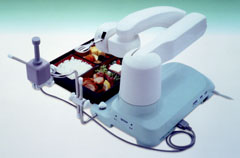 - My Spoon -- meal assistance robot (SECOM)
- My Spoon -- meal assistance robot (SECOM)
Designed to assist patients unable to use their hands, My Spoon enables users to enjoy ordinary meals by transporting food from a tray to the patient's mouth, one bite at a time. Users can select from three levels of contol -- manual (joystick control), semi-automatic or fully automatic -- to best suit their physical condition. My Spoon is available outside Japan, in the Netherlands and other locations in Europe. [More]
* * * * *
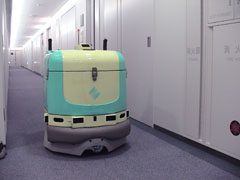 - Robotic building cleaning system (Fuji Heavy Industries/ Sumitomo)
- Robotic building cleaning system (Fuji Heavy Industries/ Sumitomo)
This autonomous robot roams the hallways of buildings, performing cleaning operations along the way. Capable of controlling elevators, the robot can move from floor to floor unsupervised, and it returns to its start location once it has finished cleaning. The robot is currently employed as a janitor at 10 high-rise buildings in Japan, including Harumi Triton Square and Roppongi Hills. [More]
* * * * *
INDUSTRIAL ROBOTS:
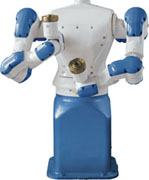 - MOTOMAN-DIA10/ MOTOMAN-IA20 (Yaskawa Electric)
- MOTOMAN-DIA10/ MOTOMAN-IA20 (Yaskawa Electric)
These industrial robot arms are capable of human-like movement, which is great news for factories worried about Japan's shrinking population (and human labor force). The DIA10 consists of two 7-axis arms mounted on a torso.
According to this spec sheet (PDF), the robot has the "finesse of the human arm without the physical limitations." The same 7-axis design is incorporated into the IA20, a "snake" robot with great freedom of movement and the ability to operate in tight spaces.
* * * * *
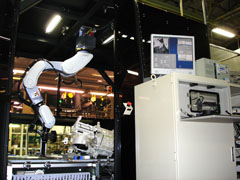 - High-speed reliability verification robot (Denso Wave)
- High-speed reliability verification robot (Denso Wave)
This robot relies on advanced machine vision technology to perform automated inspections on the go.
Highly reliable inspections can be performed at each location without stopping the line, allowing for speedier and more cost-effective operations.
[More]
* * * * *
PUBLIC SECTOR ROBOTS:
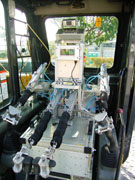 - Tele-operated construction equipment (Fujita/ Technical Office of Kyushu, Ministry of Land, Infrastructure and Transport (Kyugi))
- Tele-operated construction equipment (Fujita/ Technical Office of Kyushu, Ministry of Land, Infrastructure and Transport (Kyugi))
These remote-control unmanned construction machines were originally developed for dangerous recovery operations following disasters such as avalanches and rockslides.
Designed to prevent the occurrence of secondary disasters and greatly limit further damage and injury, these robots were deployed at the site of a disastrous mudslide that occurred in Okinawa in June 2006. [More]
* * * * *
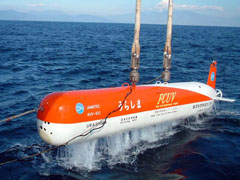 - Urashima -- deep-sea autonomous underwater vehicle (Japan Agency for Marine-Earth Science and Technology)
- Urashima -- deep-sea autonomous underwater vehicle (Japan Agency for Marine-Earth Science and Technology)
Urashima is a remotely operated vehicle for deep-sea exploration. The 10-meter long vessel relies on hydrogen-based fuel cell batteries that allow it to travel much greater distances than vessels powered by standard lithium-ion batteries. Urashima is expected to play an important role in pre-dive surveys for manned submarines and in the survey of areas considered dangerous for or inaccessible by manned research submarines. [More]
* * * * *
SMALL-TO MEDIUM-SIZED VENTURE ROBOTS:
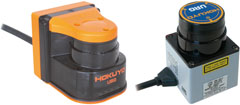
These lightweight, compact laser range finders feature low power consumption, making them ideal sensors for autonomous mobile robots. [More]
* * * * *
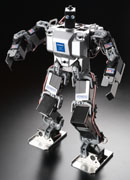 -KHR-2HV (Kondo)
-KHR-2HV (Kondo)
KHR-2HV is a high-performance build-it-yourself biped humanoid robot kit.
The popular KHR-2HV is faster, lighter and more agile than its predecessor, KHR-1, and it is packed with more controls, gears, servos and software.
Seventeen adjustable joints allow KHR-2HV to perform back flips, cartwheels and human-like moves, and USB connectivity means you can teach it lots of neat tricks. [More]
* * * * *
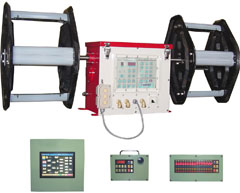 - Squid-fishing machine (Towa Denki)
- Squid-fishing machine (Towa Denki)
Towa Denki has made a number of improvements to its automated squid-fishing machines since the company began manufacturing them in the 1970s.
Relying on functions such as high-tech load detectors, squid finders and water depth detectors, the machines can perform automated operations that boost squid-fishing productivity. [More]
[Source: Robot Award 2006]
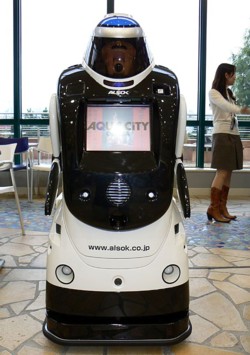 On November 27, Sohgo Security Services (ALSOK) unveiled a new security system that relies on teamwork between robots and human security guards. The system, called Reborg-Q, will be put into action at AquaCity shopping mall in Odaiba (Tokyo) in mid-December.
On November 27, Sohgo Security Services (ALSOK) unveiled a new security system that relies on teamwork between robots and human security guards. The system, called Reborg-Q, will be put into action at AquaCity shopping mall in Odaiba (Tokyo) in mid-December.
The Reborg-Q security robot, which is an upgraded version of ALSOK's Guardrobo D1, weighs 90 kilograms (200 lbs) and measures 130 x 65 x 70 cm. It can be programmed to automatically patrol a preset course, or a joystick can be used to control it remotely. The robot can also be equipped with a function to control elevators, enabling it to move from floor to floor while making its rounds.
While on patrol, four cameras mounted in the robot's head and shoulders record video, and its sensors detect the presence of humans, water leaks and fire. When the robot encounters something suspicious, it alerts a computer in the security room and sends video. Human security guards view the video footage sent by the robot and determine how to respond.
Equipped with communication functions, the robot can also provide services to the people it is watching. A touch-screen embedded in the robot's chest can be used to display information about lost children and other data about the surroundings, and a voice synthesizer enables the robot to tell the time, provide weather data and make promotional announcements.
In addition, a contactless FeliCa card reader embedded in the robot's right shoulder means it can be used to check company IDs and verify the identity of employees at company entranceways. And like Guardrobo D1, Reborg-Q can also be equipped with a fire extinguisher.
Each robot costs about 380,000 yen ($3,200), so the initial cost of a system is in the 1 to 2 million yen ($8,500 to $17,000) range. The company plans to deploy the Reborg-Q system at 10 locations around Japan in 2007.
[Source: Robot Watch]
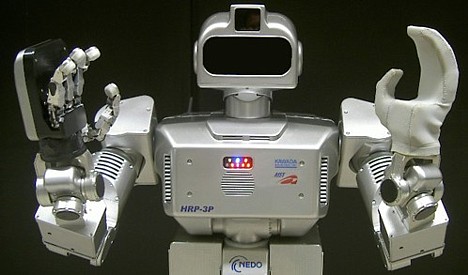
Researchers at Japan's National Institute of Advanced Industrial Science and Technology (AIST) have succeeded in boosting the manual skills of blue-collar droids by developing a robust and dexterous human-sized robotic hand.
AIST's multi-fingered hand, which is designed for use on life-sized humanoid robots, is a significant improvement over previous robot hands, which for the most part have either been too bulky or had fingers that were too weak. Humanoid robot hands in the past have tended to lack versatility and dexterity because they were designed to handle a narrow range of specific tasks or had too much emphasis placed on physical appearance.
AIST's four-fingered hand is about the size of an adult male human hand, measuring 18 cm from wrist to fingertip and 8.4 cm across the palm. Each of the three fingers and thumb are capable of exerting 15 Newtons of fingertip force -- also similar to the human hand. To mimic the movement of human hands, each finger has 4 joints and the thumb has 5 joints.
The hand is equipped with mechanisms that reduce backlash, resulting in smoother finger operation and higher-precision control of fingertip position. In addition, the drive mechanisms provide ample force to the fingertips for a strong grip, and compact sensors in the fingertips ensure the accurate application of force.
With further tests to improve the hand's mechanics and software, AIST aims to develop a human level of dexterity for the hand. This development could mean that with the android population explosion looming on the horizon, we may soon begin to see working class robots equipped with the right hands to take on our menial tasks.
[Source: AIST press release]
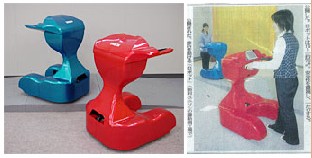 Nomura Unison Co., Ltd. has developed a walking-assistance robot that perceives and responds to its environment. The machine, called Walking Partner Robot, was developed with the cooperation of researchers from Tohoku University. It will be unveiled to the general public at the 2006 Suwa Area Industrial Messe on October 19 in Suwa, Nagano prefecture.
Nomura Unison Co., Ltd. has developed a walking-assistance robot that perceives and responds to its environment. The machine, called Walking Partner Robot, was developed with the cooperation of researchers from Tohoku University. It will be unveiled to the general public at the 2006 Suwa Area Industrial Messe on October 19 in Suwa, Nagano prefecture.
The robot is equipped with a system of sensors that detect the presence of obstacles, stairs, etc. while monitoring the motion and behavior of the user. Three sensors monitor the status of the user while detecting and measuring the distance to potential obstacles, and two angle sensors measure the slope of the path in front of the machine. The robot responds to these measurements with voice warnings and by automatically applying brakes when necessary.
Walking Partner Robot is essentially a high-tech walker designed to support users as they walk upright, preventing them from falling over. The user grasps a set of handles while pushing the unmotorized 4-wheeled robot, which measures 110 (H) x 70 (W) x 80 (D) cm and weighs 70 kilograms (154 lbs).
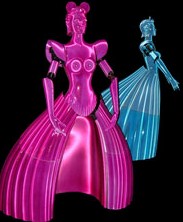 Walking Partner Robot is the second creation from the team responsible for the Partner Ballroom Dance Robot, which includes Tohoku University robotics researchers Kazuhiro Kosuge and Yasuhisa Hirata. The goal was to apply the Partner Ballroom Dance Robot technology, which perceives the intended movement and force of human footsteps, to a robot that can play a role in the realm of daily life. The result is a machine that can perceive its surroundings and provide walking assistance to the elderly and physically disabled.
Walking Partner Robot is the second creation from the team responsible for the Partner Ballroom Dance Robot, which includes Tohoku University robotics researchers Kazuhiro Kosuge and Yasuhisa Hirata. The goal was to apply the Partner Ballroom Dance Robot technology, which perceives the intended movement and force of human footsteps, to a robot that can play a role in the realm of daily life. The result is a machine that can perceive its surroundings and provide walking assistance to the elderly and physically disabled.
The developers, who also see potential medical rehabilitation applications, aim to develop indoor and outdoor models of the robot. The company hopes to make the robot commercially available soon at a price of less than 500,000 yen (US$4,200) per unit.
[Source: Nagano Nippo]
 Kokoro, a Sanrio Group company specializing in the design and manufacture of robots, unveiled its new Actroid DER2 feminine guide robot at Sanrio headquarters in Tokyo on October 4.
Kokoro, a Sanrio Group company specializing in the design and manufacture of robots, unveiled its new Actroid DER2 feminine guide robot at Sanrio headquarters in Tokyo on October 4.
Actroid DER2 is an upgraded version of Kokoro's previous fembot, Actroid DER, who has made quite a name for herself by providing services at a number of events, including the 2005 World Expo. Compared to the previous model, DER2 has thinner arms and a wider repertoire of expressions. The smoothness of her movement has also been improved, making it now even more likely for the uninitiated to confuse her with an actual human being.
Actroid's limbs, torso and facial expressions are controlled by a system of actuators powered by pneumatic pressure. Once programmed, she is able to choreograph her motions and gestures with her voice.
Kokoro intends to rent Actroid DER2 to companies and events. The basic rental fee is expected to be 400,000 yen (US$3,500) for 5 days, plus extra fees for technical support, delivery and choreography changes. For those who can't cope with a sayonara after 5 days, there is a late fee of 80,000 yen per day.
[Source: Fuji Sankei]
====================
UPDATE - Oct 7, 2006: Video via Robot Watch.
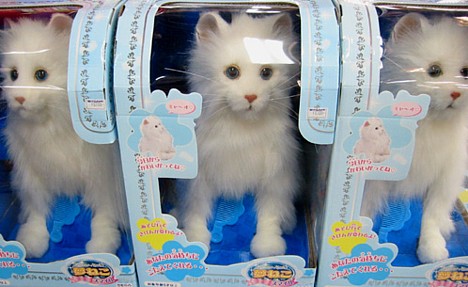
Stacks of boxed feline robots manufactured by Sega Toys, called Yume-Neko Smile ("Dream Cat Smile"), await their fate on the shelves of Tokyo toy shops. While the cats bide their time staring listlessly through the clear plastic windows of their temporary dwellings, Sega Toys steps up its efforts to find homes for them with a new TV commercial.
According to the Yume-Neko Smile homepage, the cuddly robot makes a suitable alternative for anyone unable to keep a real cat. Five sensors at different locations on Yume-Neko's body allow you and the cat to engage in tactile communication. Pet Yume-Neko Smile on the head and it starts purring and flicking its tail around. Stroke its back and it starts to get sleepy. Yume-Neko also likes it when you touch its cheek, and it apparently enjoys being flipped over on its back to have its chest stroked. The cat gets mad when you touch its tail, though, so be careful!
[Link: Yume-Neko Smile homepage]
(See also -- Video: Yume-Neko Smile, Part II)

In a move that could provide a crucial boost to our robotic friends struggling up the near side of the Uncanny Valley, major cosmetics manufacturer Kao Corporation and a Keio University research team led by robotics professor Takashi Maeno have developed an artificial skin that feels just like human skin.
Skin, the largest organ of the human body, consists of a soft layer of tissue (dermis) covered by a tougher protective layer (epidermis). The artificial skin developed by Kao and Keio mimics the feel of human skin with a 1-cm thick "dermis" of elastic silicone covered by a 0.2-mm thick "epidermis" of firm urethane. Countless tiny hexagonal indentations etched into the urethane epidermis provide it with a very realistic texture.
In a series of unscientific tests, 10 out of 12 people who touched the skin thought it felt like human skin, while equipment designed to measure the mechanical properties of skin confirmed the artificial skin had characteristics resembling human skin.
The skin was unveiled earlier this month at the 24th Annual Conference of the Robotics Society of Japan (RSJ) at Okayama University. While Kao plans to use the artificial skin in the development of new cosmetics, Professor Maeno sees potential applications in the field of household robotics, where there are many opportunities for human-robot interaction.
[Source: Yomiuri Shimbun]